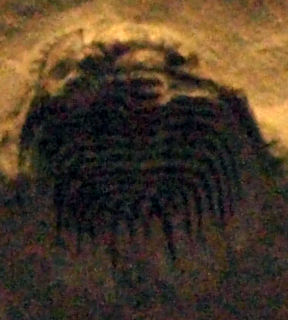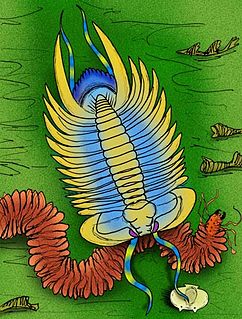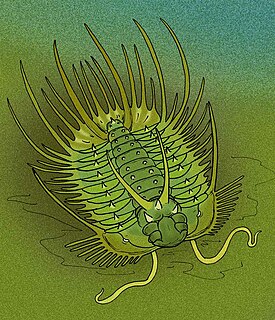
Trilobites are a group of extinct marine arachnomorph arthropods that form the class Trilobita. Trilobites form one of the earliest-known groups of arthropods. The first appearance of trilobites in the fossil record defines the base of the Atdabanian stage of the Early Cambrian period, and they flourished throughout the lower Paleozoic before slipping into a long decline, when, during the Devonian, all trilobite orders except the Proetids died out. The last extant trilobites finally disappeared in the mass extinction at the end of the Permian about 252 million years ago. Trilobites were among the most successful of all early animals, existing in oceans for almost 300 million years.

Lichida is an order of typically spiny trilobite that lived from the Furongian to the Devonian period. These trilobites usually have 8–13 thoracic segments. Their exoskeletons often have a grainy texture or have wart or spine-like tubercles. Some species are extraordinarily spiny, having spiny thoracic segments that are as long or longer than the entire body, from cephalon (head) to pygidium (tail). The sections of the pygidia are leaf-like in shape and also typically end in spines.
Acidaspis is an extinct genus of odontopleurid trilobite from the Ordovician to Silurian of North America and Europe. Although small, it had long spines along its body.

Dicranurus is a genus of Lower to Middle Devonian odontopleurid trilobites that lived in a shallow sea that lay between Euramerica and Gondwana, corresponding to modern-day Oklahoma and New York, and Morocco, respectively. As such, their fossils are found in New York, Oklahoma, and Morocco.
Dipentaspis is an extinct genus of damesellid odontopleurid trilobite. It lived during the Cambrian Period, which lasted from approximately 542 to 488 million years ago.
Adelogonus is an extinct genus of damesellid odontopleurid trilobite. It lived from 501 to 490 million years ago during the Dresbachian faunal stage of the late Cambrian Period.
Blackwelderioides is an extinct genus of damesellid odontopleurid trilobite. It lived from 501 to 490 million years ago during the Dresbachian faunal stage of the late Cambrian Period.
Dipyrgotes is an extinct genus of damesellid odontopleurid trilobite. It lived from 501 to 490 million years ago during the Dresbachian faunal stage of the late Cambrian Period.
Histiomona is an extinct genus of damesellid odontopleurid trilobite. It lived from 501 to 490 million years ago during the Dresbachian faunal stage of the late Cambrian Period.

Selenopeltis is an extinct genus of odontopleurid trilobites in the family Odontopleuridae.

Leonaspis is a widespread genus of odontopleurid trilobite that lived from the Late Ordovician to the late Middle Devonian. Fossils of various species have been found on all continents except Antarctica.
Meadowtownella is a rare genus of odontopleurid trilobite found in Ordovician rocks. It is similar to Acidaspis cincinnatiensis but without the occipital spine.

Odontopleurida is an order of very spinose trilobites closely related to the trilobites of the order Lichida. Some experts group the Odontopleurid families, Odontopleuridae and Damesellidae, within Lichida. Odontopleurids tend to have convex, bar-shaped cephalons, and lobed, knob-shaped glabella that extend to, or almost to the anterior margin. Many, if not almost all odontopleurids have long spines that are derived either from the margins of the exoskeleton, or from granular or tubercular ornamentation, or both. Many odontopleurids are so spinose so as to be described as having "spines on (their) spines." Odontopleurids have 8 to 13 thoracic segments, with Odontopleuridae odontopleurids having no more than 10, and Damesellidae odontopleurids having no more than 13. The pygidium tends to be very small, and invariably has long spines emanating from it in all known genera.

Odontopleuridae is a family of odontopleurid trilobites found in marine strata throughout the world. Odontopleurids of Odontopleuridae first appear in Late Cambrian-aged marine strata, and the last genera perish by the end of the Frasnian stage during the Late Devonian. The members of Odontopleuridae are famous for their spinose appearance, having long, often numerous spines along the edges of their exoskeletons, and derived from ends of segments or tubercle ornaments.
Cyrtoprora is an extinct genus of damesellid odontopleurid trilobite. It lived from 501 to 490 million years ago during the Dresbachian faunal stage of the late Cambrian Period.
Ceratocephala may refer to :
Ceratocephala is a trilobite genus in the family Odontopleuridae.
Orphanaspis is a poorly known genus of odontopleurid trilobite in the family Odontopleuridae. The genus is originally based on poorly preserved material from the Wenlock-aged Motol Formation in Bohemia, Czech Republic, described by Joachim Barrande, in 1852, as "Trilobites orphana." In 1945, Prantl and Pribyl reclassify T. orphana as Orphanaspis orphana. Some experts suspect that O. orphana may actually be a species of Dicranurus, thereby extending the temporal range of that, otherwise Devonian-restricted genus well into the Silurian.

Neodrepanura is an extinct genus of damesellid odontopleurid trilobite.

Odontopleura is a genus of spinose odontopleurid trilobite in the family Odontopleuridae, and is the type genus of that family and of Odontopleurida. The various species are found in Upper Ordovician to Middle Devonian marine strata throughout the world. The best studied fossils are of the type species, O. ovata, from the Wenlock-aged Liteň Formation in Loděnice, in Bohemia, Czech Republic, and, southeastern Gotland, of Sweden.








